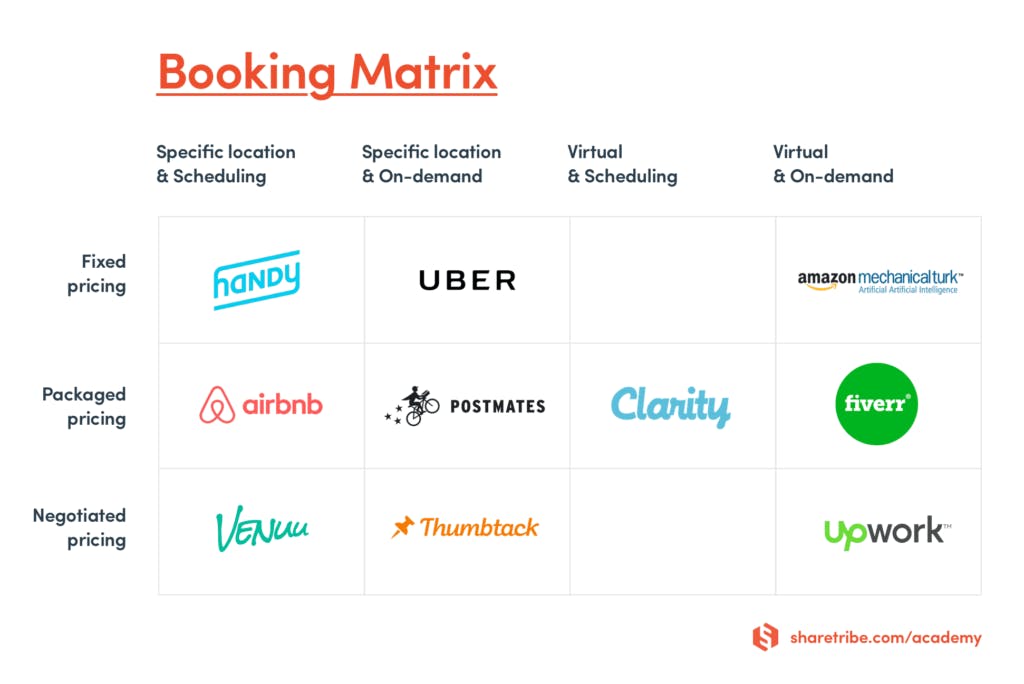- What is a marketplace?
- Marketplace types to consider in marketplace app development
- Marketplace app building blocks
- Account & user profile management
- Listing management
- Site search & discoverability
- Transaction process
- Payment integration
- Booking & availability management
- Admin features
- Marketing & communications
- Hosting, monitoring, security
- Choose your marketplace tech stack
- Set up the marketplace app framework and database
- Design the database schema
- Implement user accounts
- Implement a basic listing search
- Design and model the initial transaction process
- Implement reviews
- Implement availability management
- Build your admin UI
- About building your marketplace UI
- Code a marketplace app 90% faster with Sharetribe
- Choose your tech stack
- Download Sharetribe Web Template
- Set up your development environment
- Start customizing your marketplace app
- Launch!
- Build the marketplace UI for iOS or Android
- Integrate the Sharetribe backend
- Submit to store
Introduction: marketplaces & app development
Marketplace apps offer tremendous opportunities for the eCommerce entrepreneur.
Right now is a great time to build a marketplace app. Globally, a total of $2.67 trillion was spent on the top 100 online marketplaces in 2020. By 2024, marketplace sales are set to exceed $7 trillion.
One reason why online marketplaces are so popular lies in the opportunities of the marketplace model. Marketplaces require no initial inventory, can be built for virtually any market and niche and can grow exponentially through network effects.
Right now is a great time to build a marketplace app.
At the same time, consumers continue to spend more and more time on their mobile devices each year. In 2020, the average was over 3 hours every day. In 2019, mobile traffic already accounted for over 65% of the total traffic to eCommerce sites.
What is a marketplace?
A marketplace makes money by bringing buyers and sellers together and facilitating their transactions.
Marketplaces can work in virtually any niche, and the main offering can be anything from rentals to services to product-selling. Airbnb, Amazon, Etsy, Uber, and Upwork are all examples of successful marketplaces. For more marketplace ideas inspiration, here are some awesome Sharetribe examples.
Marketplace types to consider in marketplace app development
Marketplaces can be divided into types based on a few criteria. Let’s look at the main types from the point of view of marketplace app development.
Marketplace offering type. What your providers sell impacts the features your app needs. If you're building a product marketplaces like Etsy or a website like Amazon probably need inventory management and a shipping integration. A rental marketplace (a website like Airbnb, for example) or a service marketplace (a website like Fiverr) needs to have a booking calendar, location search, and user profiles (but has no use for a shopping cart or shipping). On-demand marketplaces (like Uber) need a powerful map that shows the real-time location of service providers.
Audience type. Different audiences have different needs. Peer-to-peer marketplace users appreciate complete user profiles, two-sided reviews, and smooth, secure payments. On B2C marketplaces, you need features that help your professional sellers manage their business. B2B marketplaces usually have complicated transaction flows and need even more custom functionality.
Booking flow type. How you design your marketplace booking flow has a big impact on the features your app will need. Do customers search for providers, or do the customers post jobs and providers bid on them? Are prices fixed or negotiated? Are bookings scheduled or happen on-demand? One way to understand booking flow types is to look at how different marketplaces relate to pricing, location, and booking schedule.

This step is important to consider carefully because building the transaction flow will take a big part of your development time. This is where using Sharetribe can make a difference: it offers a pre-built yet fully customizable transaction engine.
In addition to the categories above, there are many other ways to distinguish marketplace type, such as by horizontal/vertical focus, by marketplace business model, or by management approach. These distinctions affect how you build individual features but not the fundamentals of your marketplace. So, I’ll leave them out of the discussion and move on to outlining the building blocks of a marketplace app.
Marketplace app building blocks
Your marketplace app will consist of three fundamental components.
The marketplace backend. The backend is your marketplace’s beating heart. It’s where user-generated data is stored in a database and where your transaction engine with all user functionality lives. In chapter two of this article, I’ll list all the essential features your backend should power and outline the general project flow of building a marketplace app from scratch.
The marketplace backend is your marketplace's beating heart.
The Admin UI. Think of your admin UI as something between your marketplace backend and your user interface. It reports all your marketplace activity and lets you monitor and manage users, notifications, messages, transactions, and reviews. The admin features need to be built in the backend, and they’ll need a graphical user interface, too.
The User Interface. The UI is the branded and beautifully designed website or mobile app that your users interact with. You need different sections and features for sellers and customers, listing pages, user profiles, and content pages. The User Interface can be a web application (used through the browser with a desktop, tablet, or phone) or a native mobile application (downloaded through an app store).
In Sharetribe, we offer you the first two (fully-featured marketplace backend and a powerful admin console) out of the box. We also offer a web application that's connected to our backend, which you can launch completely no code. Your no-code web app works on our customizable website template. Familiarizing yourself with the template and using it as a basis can help speed up the UI development of your mobile app, but you can also build a completely custom user interface for either web or mobile.